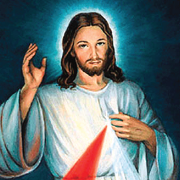Eucharist
The other sacraments, and indeed all ecclesiastical ministries and works of the apostolate, are bound up with the Eucharist and are oriented toward it. (CCC 1324)
Maisha ya kiliturujia ya Kanisa yanahusu sakramenti, na Ekaristi iko katikati (Taarifa ya Kitaifa ya Katekesi, #35). Katika Misa, tunalishwa na Neno na kulishwa kwa Mwili na Damu ya Kristo. Tunaamini kwamba Yesu Mfufuka yuko kweli na kwa kiasi kikubwa katika Ekaristi. Ekaristi si ishara au ishara ya Yesu; bali tunampokea Yesu mwenyewe ndani na kwa njia ya aina ya Ekaristi. Kuhani, kwa uwezo wa kuwekwa wakfu na utendaji wa Roho Mtakatifu, anabadilisha mkate na divai kuwa Mwili na Damu ya Yesu. Hii ni wito transubstantiation.
By the consecration the transubstantiation of the bread and wine into the Body and Blood of Christ is brought about. Under the consecrated species of bread and wine Christ himself, living and glorious, is present in a true, real, and substantial manner: his Body and his Blood, with his soul and his divinity. (CCC 1413)
The New Covenant
Mimi ndimi chakula chenye uzima kilichoshuka kutoka mbinguni; aulaye mkate huu ataishi milele;…Aulaye mwili wangu na kuinywa damu yangu anao uzima wa milele na…akaa ndani yangu nami ndani yake. ( Yohana 6:51, 54, 56 )
In the gospels we read that the Eucharist was instituted at the Last Supper. This is the fulfillment of the covenants in the Hebrew Scriptures. In the Last Supper narratives, Jesus took, broke and gave bread and wine to his disciples. In the blessing of the cup of wine, Jesus calls it “the blood of the covenant” (Matthew and Mark) and the “new covenant in my blood” (Luke).
This reminds us of the blood ritual with which the covenant was ratified at Sinai (Ex 24) -- the sprinkled the blood of sacrificed animals united God and Israel in one relationship, so now the shed blood of Jesus on the cross is the bond of union between new covenant partners -- God the Father, Jesus and the Christian Church. Through Jesus’ sacrifice, all the baptized are in relationship with God.
The Catechism teaches that all Catholics who have received their First Holy Communion are welcome to receive Eucharist at Mass unless sin a state of mortal sin.
Anyone who desires to receive Christ in Eucharistic communion must be in the state of grace. Anyone aware of having sinned mortally must not receive communion without having received absolution in the sacrament of penance. (CCC 1415)
The Church warmly recommends that the faithful receive Holy Communion when they participate in the celebration of the Eucharist; she obliges them to do so at least once a year. (CCC 1417)
Kupokea Ekaristi hutubadilisha. Inaashiria na kuathiri umoja wa jumuiya na inatumika kuimarisha Mwili wa Kristo.
Kuelewa Misa
The central act of worship in the Catholic Church is the Mass. It is in the liturgy that the saving death and resurrection of Jesus once for all is made present again in all its fullness and promise – and we are privileged to share in His Body and Blood, fulfilling his command as we proclaim his death and resurrection until He comes again. It is in the liturgy that our communal prayers unite us into the Body of Christ. It is in the liturgy that we most fully live out our Christian faith.
The liturgical celebration is divided into two parts: the Liturgy of the Word and the Liturgy of the Eucharist. First we hear the Word of God proclaimed in the scriptures and respond by singing God’s own Word in the Psalm. Next that Word is broken open in the homily. We respond by professing our faith publicly. Our communal prayers are offered for all the living and the dead in the Creed. Along with the Presider, we offer in our own way, the gifts of bread and wine and are given a share in the Body and Blood of the Lord, broken and poured out for us. We receive the Eucharist, Christ’s real and true presence, and we renew our commitment to Jesus. Finally, we are sent forth to proclaim the Good News!


